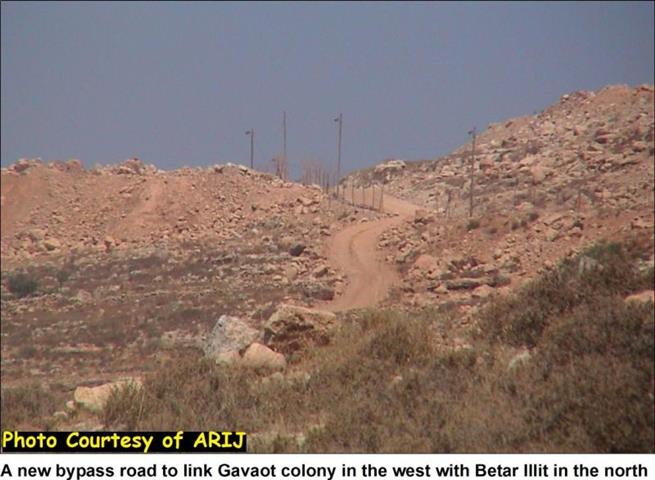On Wednesday morning, August 13, 2003, while the cool breeze of the mountains is still embracing the Palestinian village of Al-walaja East of Bethlehem district, a large number of Israeli troops accompanied by armored ironclad vehicles and bulldozers with a number of rackety police dogs broke up the usual calmness of the small village. Five houses were demolished and 7 Palestinian families became homeless as a result of this obtrusion.
The Israeli bulldozers started closing the secondary roads of the village with earthred blocks and a sudden curfew was imposed over 1234 Palestinian inhabitants. The massed Israeli Occupation Forces-IOF moved into the village and specifically to the demarcated five houses forcing their residents to go out and leave everything behind. See Photo 1
Careless foreigner workers accompanied the Israeli soldiers to the house and began discarding furniture and electric devices from the windows of the second floor. This caused a severe damages to the contents of the houses; at the same time, instigated the anger in the householders who stood forcedly away under the threat of the Israeli weapons. The process of house demolision started ; consequently, destroying the only shelter of the seven families.
Some of the demolished houses were still under a legal dispute in the Israeli court of Jerusalem for many years. In some cases, the Israeli court foiled the people by asking them to pay a fee reaches 50000 NIS (10638 EURO). A final deal between the householders and the Israeli court came out in order not to issue demolition orders through splitting the payment of the fee to be paid over several months. This deal was still ongoing when the Israeli bulldozers demolished the houses. See Photo 2
The demolished houses belong to:
-
Mohammed Mousa Abd El Sheikh; two floors building with a total area of 260 square meters and provide shelter for 22 persons. The demolition of the second floor caused severs damage to the first one that attained a building permission in 1967. The appointed lawyer succeeded to bring a court call to stop the demolition of the house. The order was given to the Israeli Authority through the village council but with no results.
-
Mahmmoud Mohammed Al Araj; two floors building with a total area of 220 square meters and provide living for 8 persons. A complete damage to the building occurred including its contents. The householder already paid a large amount of money from the fee to the Israeli court.
-
Salim Abu Rezeq ; a 60 square meters house accommodate 4 persons.
-
Maher Mahmoud Radwan; a 60 square meters house.
-
Walid Ata Rabah; a 70 square meters house.
Ghettos seem to be an Israeli fashion imposed on Palestinian cities, towns and villages
The Ghetto Of Al Walaja Village
Parallel to the offensive campaign of house demolition, the policy of Land grab is continuous. On August 12, 2003, a military order no.03/44/T was issued by Gadi Ezinkot, the Israeli Commander of Yehuda and Samaria region, ordering the annexation of 23.8 dunams of land belongs to Palestinians from AL-walaja and Beit Jala residents. The claim behind this seizure was as usual for ''security needs'', see the military order [In Hebrew].
The route of the land being seized is clearly showing the intention behind such violation; to circulate Al Walja village as a part of the so called ''Jerusalem envelope''. A military fenced road will circulate the village from its four sides and limits the possibility for any natural expansion; moreover, it will imprison the inhabitants in a new ghetto, see satellite map; thus, isolating the northwest part of the village which is close to the Israeli illegal boundary of Jerusalem.
'This offensive Israeli attack on the Palestinian village of Al walaja is one of programmed series of attacks which aim at evacuating the land from its legitimate Palestinians owners'. Mustafa Abu Al-Teen the village council leader reported to ARIJ field worker. He also added that, ''the displacement policy adapted by the Israeli Occupation Forces against Al walaja residents is getting stronger and the pressure is increasing while the Israeli actions of house demolition and land confiscation are continuous. In addition, the village is subjected to a long closure and isolation from the surrounding Palestinian communities for almost two years which put the inhabitants of the village under harsh living conditions.''
Prepared by:
The Applied Research Institute – Jerusalem

















